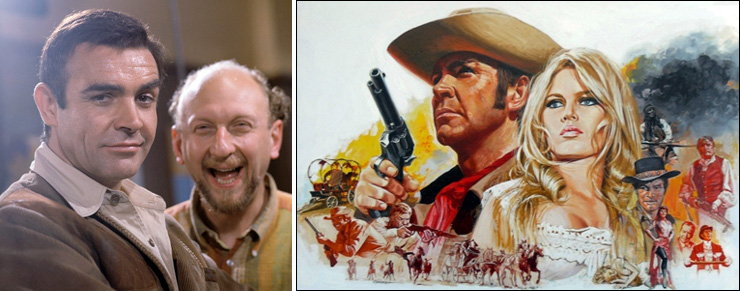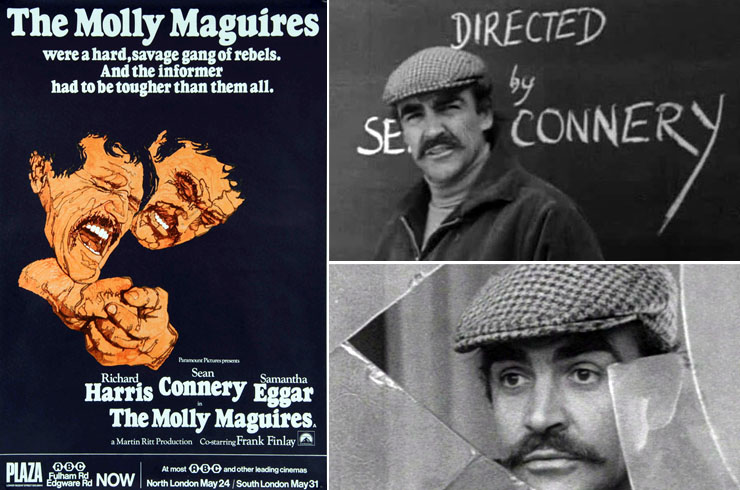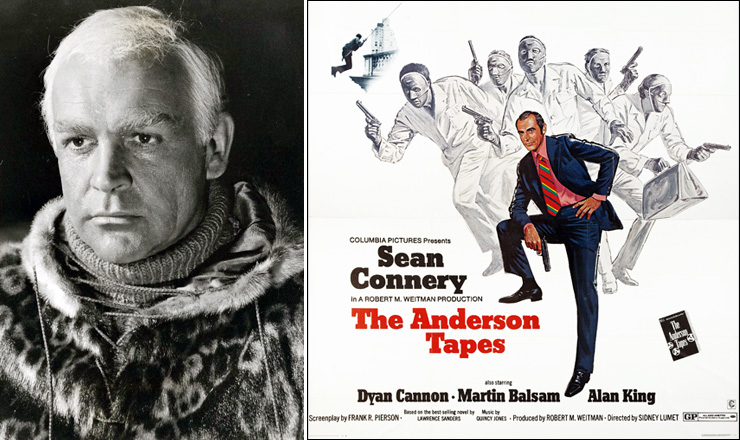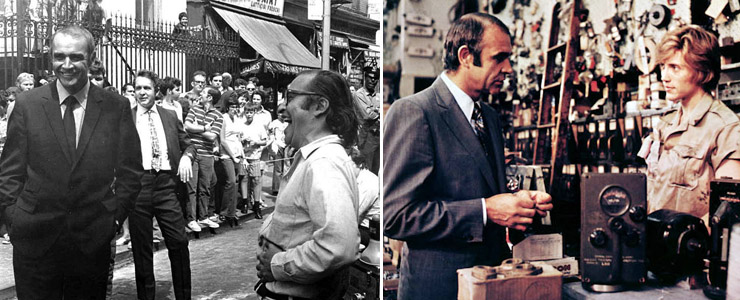| |
31 October 2020 |
|
Sir Sean Connery
1930-2020
|
|
|
Part 2: Beyond Bond
In 1966 just after the release of Thunderball, Sean Connery
filmed A Fine Madness in New York with director Irvin Kershner (who
also directed Never Say Never Again in 1983).
Starring opposite Paul Newman's wife Joanne Woodward, Connery took on the
comedy in another attempt to break free from the mantle of James Bond. Now
largely forgotten, the film was not very well-received and
proved somewhat of a box-office failure. |
 |
|
ABOVE: (left) A
Fine Madness (1966) Sean Connery with director Irvin
Kershner with whom he would reunite in 1983 to make Never Say
Never Again. (right) Original UK artwork by renowned British
poster artist Tom Chantrell (1916-2001) for Shalako (1968) Sean Connery's first film made after his departure from the James Bond
series. |
|
|
|
Sean Connery's first film
after his departure from the Bond series was Shalako (1968), a
western directed by Edward Dmytryk. Set in New Mexico in 1880 (although
filmed in Almeria, Spain like so many other 1960s westerns), the film
co-starred Brigitte Bardot, and reunited Connery with Honor Blackman and
Goldfinger cinematographer Ted Moore. The action scenes were
arranged by Bob Simmons, who had performed the same duties on four of
Connery's five James Bond films. Working on Shalako, Simmons was
therefore unable to arrange the stunts for newcomer George Lazenby, who
was then shooting On Her Majesty's Secret Service in Switzerland.
Although Shalako performed well at the box-office and was very
popular on its original release, this film too ended up losing money
because of its high production costs. |
|
 |
|
In 1970 Sean Connery
starred in The Molly Maguires as the leader of a secret
organization of Irish coal miners in nineteenth century Pennsylvania, who
fought against oppressive mine owners. Directed by Martin Ritt and
co-starring Richard Harris, the film was once again a box-office disaster,
although it rekindled Connery's interest in labour relations, which had
begun in 1967 when he directed the documentary The Bowler and the
Bunnet for Scottish Television. The one-hour black & white film was Connery's only
directorial effort, and was a critical examination of the Fairfield
Experiment, focussing on the new working practices introduced at the
Fairfield shipyard in Glasgow. |
 |
|
ABOVE: (left) Sean Connery played heroic
Norwegian explorer Roald Amundsen (1872-1928) in the rarely-seen
1969 Soviet/Italian co-production The Red Tent which was
not released in the USA until 1971. (right) Poster artwork for
Sidney Lumet's The Anderson Tapes (1971) which features
Sean Connery in a James Bond-like pose - the image was used in
several US newspapers to advertise re-releases of his 007 films in
the mid-1970s. |
|
|
|
Although top-billed in
The Red Tent, Sean Connery played what amounted to a supporting role
as Roald Amundsen in the joint Soviet/Italian film directed by Mikhail
Kalatozov. Filmed in 1969, The Red Tent was not shown in the USA
until 1971, when it was released in a version 37-minutes shorter than the
Russian original. Rarely seen since its original release, The Red Tent
remains another curiosity in Sean Connery's varied body of work. Reunited
again with director Sidney Lumet in 1971, Connery then took on the starring role
of burglar John Duke Anderson in the crime thriller The Anderson
Tapes. Co-starring Dyan Cannon and Martin Balsam, with a young
Christopher Walken making his screen debut, The Anderson Tapes was
a modest commercial success and finally restored Sean Connery as a major
box-office star in the USA. |
 |
|
The release of On Her
Majesty's Secret Service in 1969 had been a big gamble on the part of
EON Productions and distributor United Artists. Although the sixth James
Bond film was a box-office success, it was nowhere near as popular as the
five Sean Connery
films that preceded it. With newcomer George Lazenby proving difficult
during the shooting of On Her
Majesty's Secret Service, and ultimately resigning from the role of
007 before the film was even released, United Artists knew that if they
were to make another successful Bond film there was only one man for the
job, and that man was Sean Connery.
|
|
Part
3: Back to Bondage |